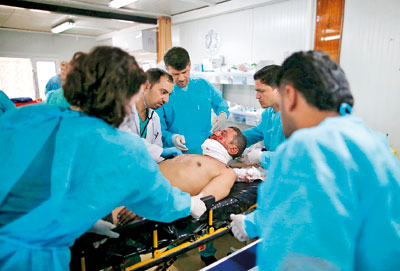Sunday Times 2
Even with hi-tech war kit, US can’t prevent civilian deaths in Iraq
View(s):By Laurent Barthelemy
WASHINGTON (AFP) – Despite using state-of-the-art weaponry, the US-led coalition fighting the Islamic State group in Iraq appears unable to avoid civilian casualties as it battles the jihadists in close urban combat.The coalition is backing Iraqi forces in the battle to push out IS from west Mosul, a maze of narrow and densely populated lanes in which residents must hunker down in a bid to avoid bombs and bullets.
The commander of the US-led forces admitted this week that they “probably had a role” in casualties caused by an explosion on March 17, which local sources said left dozens of non-combatants dead. But the US military has also repeatedly denounced what they call the jihadists’ use of civilians as human shields — and now accuses them of trying to provoke the coalition into making deadly blunders.
 The anti-IS forces have the most up-to-date technology for warfare, enabling GPS and laser-guided bombs, video surveillance by drone and online interception of jihadist activity. Yet their opponents are “smuggling civilians so we won’t see them and trying to bait the coalition to attack,” said US Colonel Joe Scrocca, a spokesman for the Baghdad-based coalition.
The anti-IS forces have the most up-to-date technology for warfare, enabling GPS and laser-guided bombs, video surveillance by drone and online interception of jihadist activity. Yet their opponents are “smuggling civilians so we won’t see them and trying to bait the coalition to attack,” said US Colonel Joe Scrocca, a spokesman for the Baghdad-based coalition.
He said they had for the first time on Wednesday caught jihadists on video who “forced civilians into a building, killing one who resisted, and then used this building against the CTS (Iraqi counter-terrorist forces).”
Fears for civilians
Since the west Mosul offensive began in mid-February more than 300 civilians have been killed, according to the United Nations — although it is not clear how many deaths are attributable to each side.
Some 200,000 people have fled the area over the same period, and the Pope, the UN and Amnesty International have all called in recent days for greater efforts to protect citizens.
London-based NGO Airwars, which monitors civilian casualties of international airstrikes, said victims of coalition bombs in Iraq and Syria increased in March to a level comparable with “some of the worst periods of Russian activity in Syria.” The rise to power of US President Donald Trump, who promised to “bomb the shit” out of the IS group, has fed suspicions that the new administration is giving a freer rein to its military — if necessary, by accepting more collateral damage.
But US Lieutenant General Stephen Townsend, who leads the coalition, said there had been only “relatively minor adjustments” to the rules of engagement since he came into command last August, and that these did not factor in the March 17 strike.
Speaking to reporters on Tuesday in a phone briefing from Iraq, he insisted that “our care, our caution, our applications of the rule of force… our tolerance for human casualties, none of that has changed.” Townsend described the fighting as “the most significant urban combat to take place since World War II.”
“It is the toughest and most brutal close-quarters combat that I have experienced in my 34 years of service,” he said.
Along with civilian casualties, Iraqi troops have suffered significant losses, with nearly 300 men killed since the west Mosul pushback began over a month ago.
Seconds to act
US military officials say they have boosted precautions to avoid civilian victims.“We don’t need to use a 500-hundred-pound bomb which is going to destroy a building if we can use a Hellfire missile which is just going to blow out a room and kill some fighters,” said Scrocca.
A US defence official told reporters this week that they always try to have video images of the targets that Iraqi forces ask them to strike.
“We have to be able to positively identify the valid military target (and) positively identify the combatant,” as well assess the potential collateral damage of a strike, the official said, speaking on condition of anonymity.
But in some circumstances, the decision to strike must be taken in seconds. “It is very difficult to mitigate” the risk of civilian casualties when we have to address “an immediate threat coming from a building,” the source said. Townsend has delegated the right to approve bombings further down the hierarchy to allow a quick response to help Iraqi troops.
And despite the dangers, Iraqi forces are making progress — Scrocca said they now believe there are fewer than 1,000 IS fighters in west Mosul, from an estimated 2,000 mid-February.
“Make no mistake about it, (IS) will continue to cause massive human suffering if the Iraqi security forces and coalition do not prevail,” said Townsend.

